Can road design reduce carbon emissions?
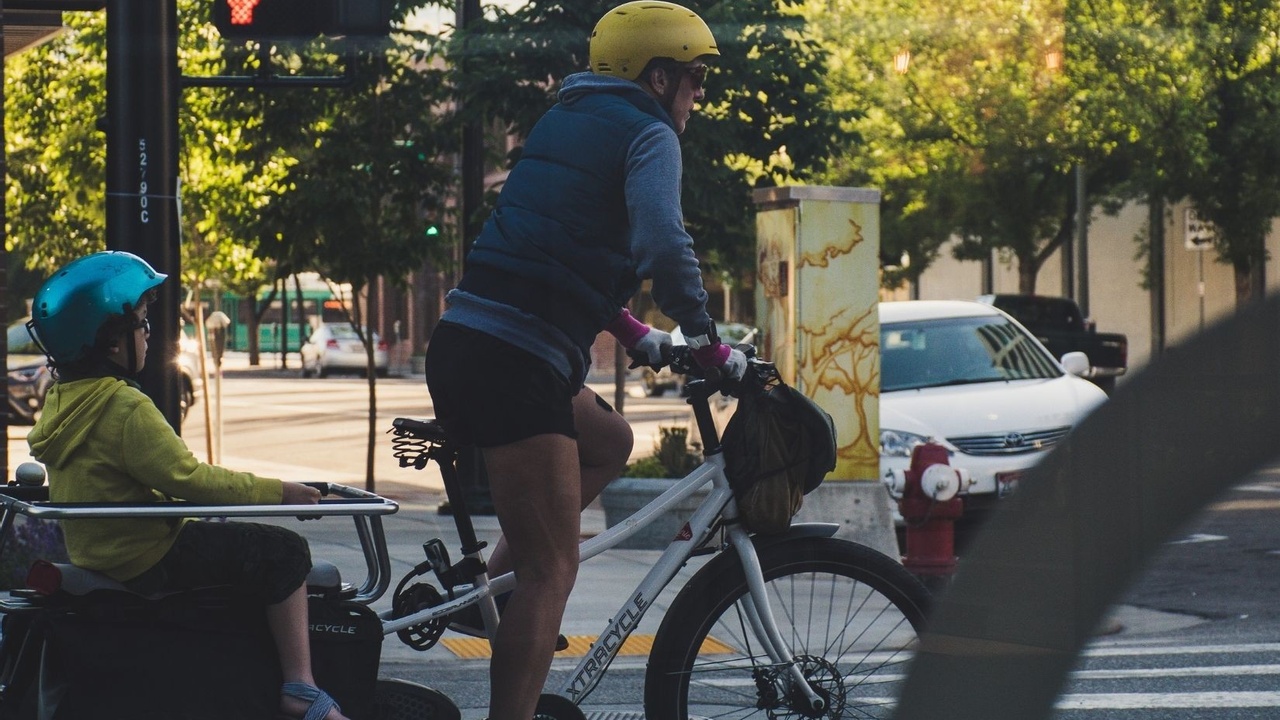
Reducing the prevalence of cars in cities is an important part of creating more sustainable cities. We know that automobiles emit harmful pollutants such as carbon dioxide and reduce walkability, so we need to ask ourselves, “what can we do to minimize their usage?”
While there are many methods of reducing automobile usage, such as the promotion of active transportation through the creation of urban walking trails, bike lanes, and the utilization of Transit Oriented Design, the reality is that vehicles will continue to be used for quite some time.
For one, they are practical when travelling long distances and can accommodate large groups of people (ie. busses). In addition, electric vehicles are gaining popularity which means that the overall environmental impact of automobiles will be reduced!
Prioritizing road safety
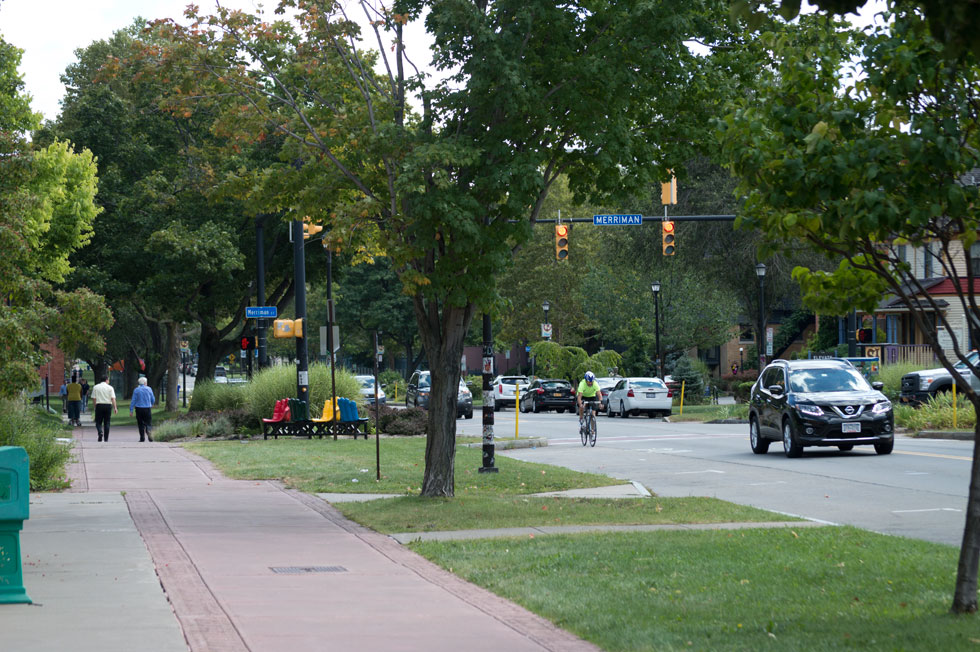
Photo sourced from: Streets for the People
This is why it is necessary to make our roadways as safe as possible. As long as vehicles are around, they pose a serious threat to those near them and in them. Did you know that according to the Association for Safe International Road Travel, approximately 1.35 million people across the globe die in road crashes on an annual basis? More than half of those fatalities are vulnerable road users such as pedestrians, cyclists, and motorists.
As more and more people choose active transportation over driving, this will create more pedestrians and cyclists who need to be protected against motor vehicle traffic. And of course, we want to make driving safer for divers and passengers as well. Basically, everyone wins when we improve the safety of our roads.
So, how exactly do we do this?
Traffic calming devices just might be the answer!
Traffic calming involves the use of physical road design or other measures to slow vehicles down as they drive through urban areas, whether they be residential or commercial. The main point of traffic calming devices is to reduce driving’s position as the most dominant method of transportation, therefore creating greater equality between transportation methods.
With the way things are now in many cities which have been designed around the automobile, driving is the most favoured and prioritized method of transport.

When most emphasis is placed on the automobile, other (and more environmentally friendly) methods of transportation are sidelined. As a result, people become discouraged from walking, biking, roller skating, or any other method of active transportation, as they become less safe and more time consuming.
Low tech solutions
There are many different traffic calming measures that can be used in cities all over the world. Some of these measures are high-tech, meaning that technology or signage is implemented on the road itself to make drivers more aware of their speed. For example, radar signs which give drivers immediate feedback about their speed are quite common.
However, the great thing about traffic calming measures is that they actually don’t have to be high-tech at all. There are tons of low-tech options which are relatively inexpensive and flexible.
Here are some low-tech traffic calming measures that have proven to be quite successful:
Reassessing street width
Did you know that the width of our streets and sidewalks influences driving speeds? A study presented at the Canadian Institute of Traffic Engineers conference, authored by Dewan Masud Karim, identifies that roads with the widest lanes (12 feet or wider) are associated with greater crash rates and higher impact speeds.
In addition to speed, the width of streets also conveys the relative importance of different transportation methods. For example, wide streets and narrow sidewalks indicate that drivers are the main method of transportation, and as a result, have the right of way.
By narrowing our streets and widening our sidewalks, we can reduce traffic speeds and create a more pedestrian-friendly space. Other ways to narrow streets include converting traffic lanes into bus-only or trolley lanes or adding bicycle lanes.

These options are quick and inexpensive fixes, as all they may require is a new paint job – and some education.
More tangible benefits of less pavement
Of course, building new roads that are narrower can be great for the climate on a few different fronts, reduced concrete needed to build the road reduces the initial carbon emissions of that road-build, but it also reduces the amount to pavement that needs to be maintained, cleaned, and repaired.
Plus, narrower roads with less pavement overall allow for less solar gain, contributing less to the Urban Heat Island effect, and can allow for more permeable surfaces in our towns and cities, reducing the potential for flooding and stormwater overflows as more moisture is able to penetrate the ground during rainfall or snowmelt.
These benefits become increasingly important in the face of climate change and the expectation, and reality, of more extreme temperatures and rainfall.
Roundabouts
Roundabouts are large circular islands that are located in the middle of intersections instead of traffic lights. Drivers are required to travel around these roundabouts until they reach the street they would like to turn on to.
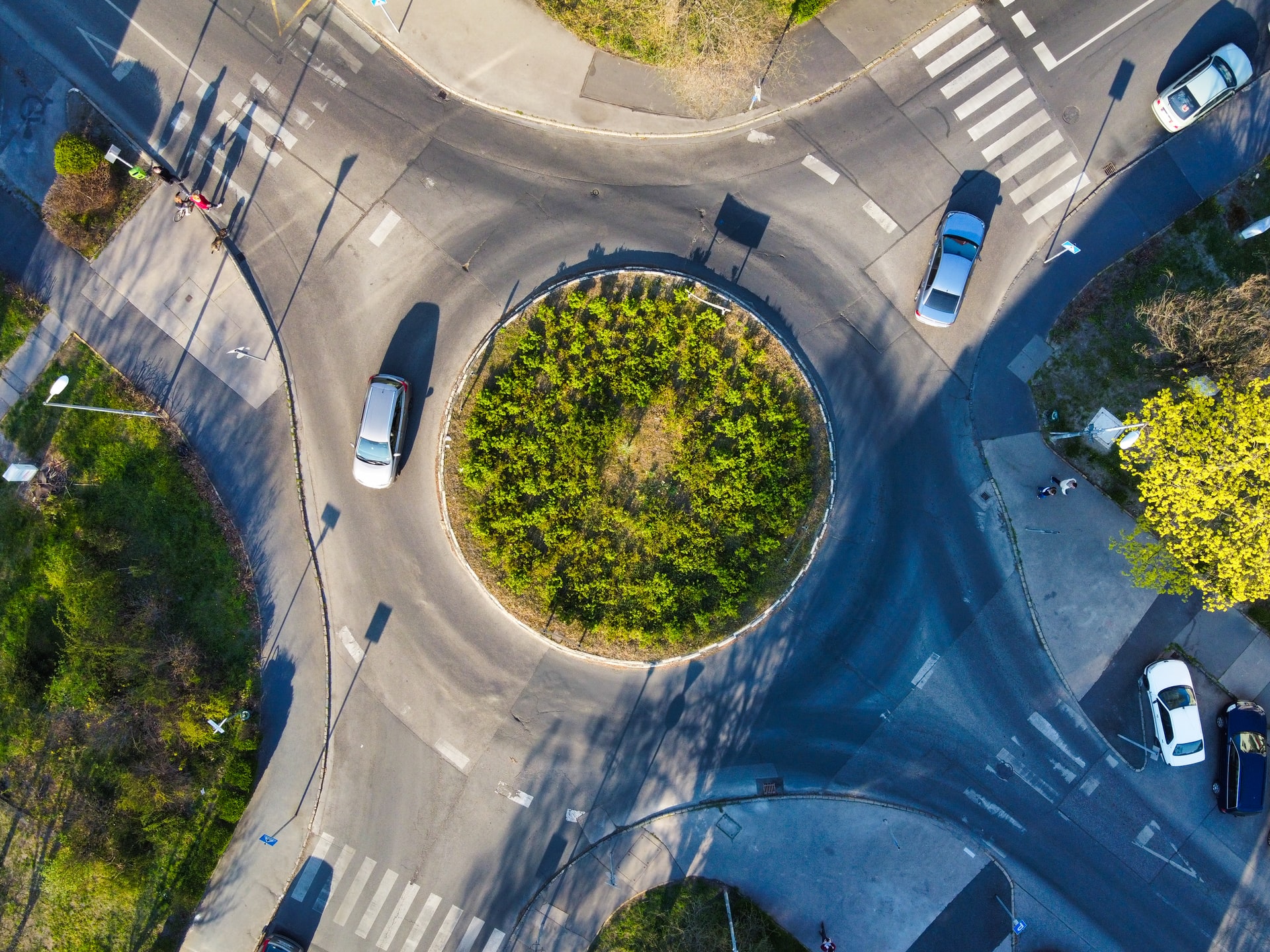
One benefit is that streets often narrow as they approach roundabouts, signaling drivers to slow down and pay attention to their surroundings. This is useful, as drivers can become dangerously fixated on traffic lights, not even realizing what is going on outside their vehicles!
Roundabouts also reduce the amount of collision points between vehicles, therefore leading to fewer accidents.
Lastly, the centres of roundabouts are great spaces for some attractive landscaping, sculptures, or other aesthetically pleasing features.
Speed humps and rumble strips
Sometimes drivers need a physical or aural reminder to slow down. This is where speed humps and rumble strips come in handy.

Speed humps are rounded mounds, approximately 3 inches high and 10-12 feet long, which are placed across roads. Drivers are forced to slow down when driving over speed humps otherwise their car can be damaged. The key to these devices is to place them at regular intervals in order to prevent vehicles speeding up between them.
Rumble strips are raised concrete lines or patterns which are placed across roadways for the same reason. Driving over them causes an unpleasant sound and vibration that can be minimized at slower speeds.
A little bit of nature goes a long way
Another cool and environmentally beneficial way to reduce speeds and calm traffic is by adding elements of nature to roadways.
Trees, planters, and shrubbery can often be found on the sides of streets or on a median. These serve a few different purposes. For example, trees located on either side of a street helps to reduce the optical width of the street, therefore discouraging speeding.
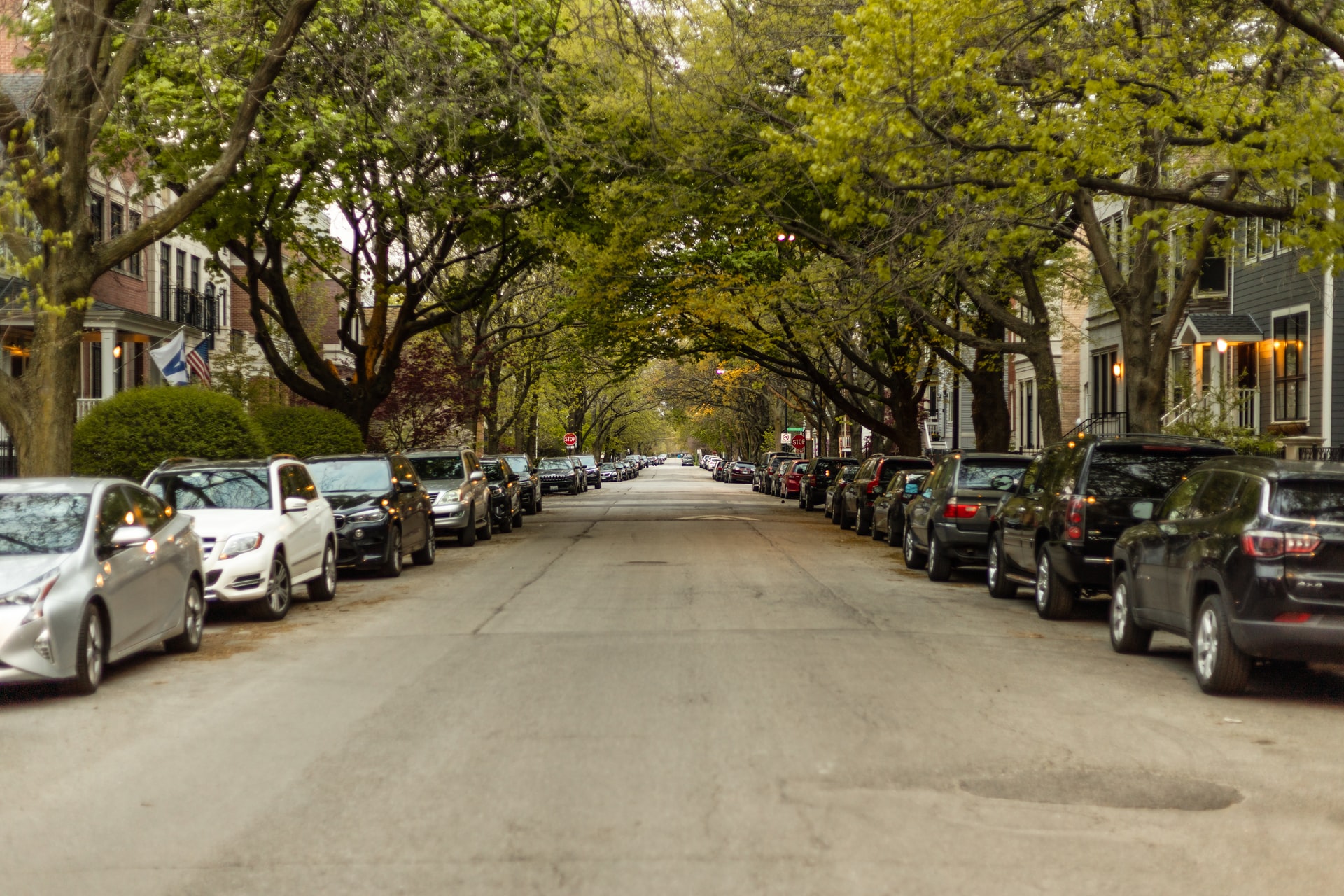
Planters, trees, and shrubs may also be placed on raised medians between streets. These plant-filled medians serve to narrow street space and create a space for pedestrians to pause safely when crossing the street.
And of course, these plants help increase the visual appeal of the streets, therefore creating a safer and pedestrian-friendly space, and adding to the green infrastructure of our towns and cities.
Putting Streets on a Diet
Narrower streets tend to have slower traffic speeds and fewer accidents, so aside from designing and building narrower roads, how do we make existing infrastructure safer and narrower? Well, there are plenty of interesting solutions here too. Allowing street parking on one or both sides of the street is one way to make the street narrower, and building out the parking curb with a bump out to indicate that it is used for parking can add an element of nature into the design as well.
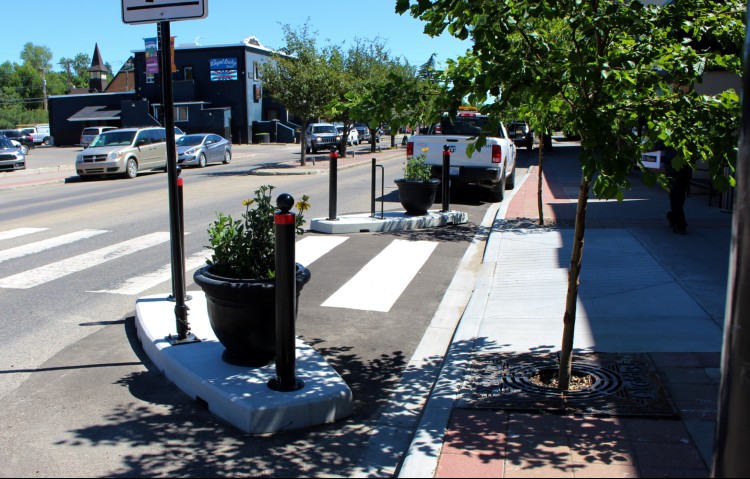
Image sourced from: Okotoks Online
Planters placed on the road can also beautify while narrowing a stretch of road. And some communities even have used artwork that is approved by the municipality to help slow traffic. These elements can also add a sense of community, as well as beautify, when they are developed and executed by the community.
Narrowing a street, even for a short segment is effective in reducing speed, and encouraging drivers to pay more attention. A side benefit is that drivers tend to also pay more attention to the shops on the street as they drive slower, and this can also assist local businesses.
Making green a reality
Now, you might not be thinking about roads too much in your quest for living a greener, more eco-friendly life, but the reality is that to have more people using active transportation, we need to make those roads as safe and user friendly to cyclists and pedestrians as possible. In the end, safe streets benefit everyone.
In the end, road design is an important aspect of facilitating a shift towards a lower carbon future. One where people can safely choose active transportation instead of driving, and where neighbourhoods benefit from slower traffic, beautified streets, more shade, less pavement, and lower road maintenance costs.
This almost makes traffic calming devices sound interesting doesn’t it!
Stay connected with news and updates!
Join my mailing list to receive the latest news and updates. Your information will not be shared.

